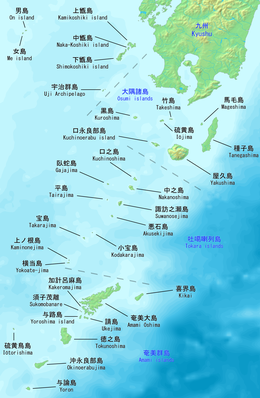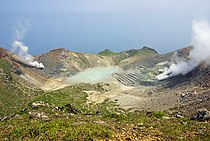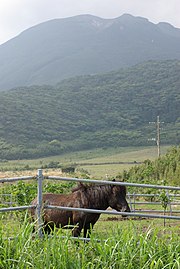| This article needs additional citations for verification. Please help improve this article by adding citations to reliable sources. Unsourced material may be challenged and removed. Find sources: "Tokara Islands" – news · newspapers · books · scholar · JSTOR (July 2024) (Learn how and when to remove this message) |
| Native name: 吐噶喇列島 (トカラ列島), Tokara rettō | |
|---|---|
 Akusekijima Akusekijima | |
 Map of Kagoshima Prefecture Map of Kagoshima Prefecture | |
| Geography | |
| Coordinates | 29°58′00″N 129°55′01″E / 29.9667°N 129.917°E / 29.9667; 129.917 |
| Adjacent to | Pacific Ocean |
| Total islands | 12 |
| Area | 101.35 km (39.13 sq mi) |
| Administration | |
| Japan | |
| Prefectures | Kagoshima |
| District | Kagoshima District |
| Village | Toshima |
| Demographics | |
| Population | 648 (2010) |
| Pop. density | 6.39/km (16.55/sq mi) |
| Ethnic groups | Japanese |
The Tokara Islands (吐噶喇列島, Tokara-rettō) is an archipelago in the Nansei Islands, and are part of the Satsunan Islands, which is in turn part of the Ryukyu Archipelago. The 150 kilometres (81 nmi) chain consists of twelve small islands located between Yakushima and Amami-Oshima. The islands have a total area of 101.35 square kilometres (39.13 sq mi). Administratively, the whole group belongs to Toshima Village, Kagoshima Prefecture, Japan. Only seven of the islands are permanently inhabited. The islands, especially Takarajima, are home to the Tokara horse.
Etymology
| This section does not cite any sources. Please help improve this section by adding citations to reliable sources. Unsourced material may be challenged and removed. Find sources: "Tokara Islands" – news · newspapers · books · scholar · JSTOR (July 2024) (Learn how and when to remove this message) |
One theory holds that the name “Tokara” was derived from “tohara”, or “distant sea area”, as viewed from Okinawa. Another theory states that the name come from the Ainu word tokap, which means “breast”. The southernmost inhabited island in the archipelago, Takarajima, has a mountain, Megamiyama (lit. Goddess Mountain) with such a shape.
History
| This section does not cite any sources. Please help improve this section by adding citations to reliable sources. Unsourced material may be challenged and removed. Find sources: "Tokara Islands" – news · newspapers · books · scholar · JSTOR (July 2024) (Learn how and when to remove this message) |
Mention is made in the Shoku Nihongi under an entry for the year 699 of an island called “Tokan”, which is usually identified with Tokara, together with the islands of Tane, Yaku and Amami, although “Tokan” is also sometimes identified with Tokunoshima, an island approximately 150 kilometres (93 miles) away. (While an entry in the earlier Nihon Shoki for the year 654 mentions a "Tokara Country", Tokara no kuni, it is a reference to the Tokhara region of Central Asia, rather than the Tokara Islands.) During the 15th and 16th centuries, the islands came under the control of the Shimazu clan of Satsuma Domain and the Ryukyu Kingdom. Ryukyu ceded its territory in the Tokara Islands to Satsuma in 1611, which was confirmed by the Tokugawa Shogunate in 1624.
In 1908, the islands were administratively organized into Jitto Village, literally “Ten islands”, of which seven were inhabited. After World War II, from 2 February 1946 all of the Satsunan islands south of 30th Latitude, including the Tokara Islands, were placed under United States military administration as part of the Provisional Government of Northern Ryukyu Islands. However, the three northern inhabited islands in the archipelago, Iōjima, Kuroshima and Takeshima, remained under the control of Japan, and were placed under the administration of the village of Mishima. The remaining Tokara Islands reverted to Japan on 10 February 1952 and are now administered as the village of Toshima.
Important Bird Area
The islands have been recognised as an Important Bird Area (IBA) by BirdLife International because they support populations of Japanese wood pigeons, Ryukyu green pigeons, Ijima's leaf-warblers, Izu thrushes and Ryukyu robins.
Islands


References
- National Geospatial Intelligence Agency (NGIA). Prostar Sailing Directions 2005 Japan Enroute. Prostar Publications (2005). ISBN 1577856511
- "Tokara Islands". BirdLife Data Zone. BirdLife International. 2021. Retrieved 1 February 2021.
- "Toshima" (PDF). 2004. Archived from the original (PDF; 19 kB) on 4 July 2011. Retrieved 6 July 2013.
- 平 瀬 – トカラ列島 [Hirase – Tokara Islands]. National Institute of Advanced Industrial Science and Technology (in Japanese). Archived from the original on 24 January 2013.
External links
 Tokara Islands travel guide from Wikivoyage
Tokara Islands travel guide from Wikivoyage- Official website in Japanese
- Topographic Map 1:250.000
